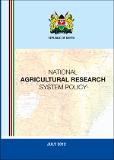Review of Food and Agricultural Policies in Kenya 2005-2011
Publication Date
2013Author
Type
Book chapterviews
downloads
Metadata
Show full item recordBy
Monitoring African Food and Agricultural Policies (MAFAP)
Abstract/
This report constitutes the first agricultural policy review undertaken by the MAFAP project in Kenya. The report reviews the main developments of the economy and the agricultural sector as well as the main policy decisions affecting this sector. However, its main contribution focuses on: a) an analysis of price incentives and disincentives faced by farmers and consumers for ten agricultural commodities, which cover a significant share of agricultural production, imports, exports and diet; and b) a detailed analysis of the composition and level of public expenditure in support of agriculture and rural development. The former analysis was made for the period 2005-2010, while the latter covers 2006 to 2011. The commodity analysis is designed to identify how the current policy environment affects agriculture through its influence on commodity markets. It is based on well-known, simple indicators to measure the deviation of commodity prices received by various agents in domestic markets from an estimated ideal price in a distortion-free, competitive situation, referred to in this report as the reference price. The deviation is measured in monetary value per unit of marketed output (price gap) and in relative terms as a percentage of the reference price (nominal rate of protection). The reference price takes into account whether the commodity is an export, import or thinly traded product in world markets; the marketing costs currently incurred; and all taxes or levies. According to this indicator, when the domestic price is equal to the reference price, there are no distortions to farm incentives, indicating that the domestic prices are consistent with the comparative advantage of the country in producing the commodity. A domestic price above the reference price of the commodity suggests that producers are receiving transfers through the market or incentives due to existing policy or functioning of the value chain. On the other hand, producers are facing disincentives originating from policies or market factors when the domestic price is below the reference price.
Publisher
Food and Agriculture Organization of the United NationsSeries
Book Chapter;2005-2011Collections
Related items
Showing items related by title, author, creator and subject.
-
National Agricultural Research System Policy 2012
Agricultural Sector Coordination Unit (ASCU) (Ministry of Agriculture, 2012)The policy objectives are: improving agricultural research policy framework; harmonizing and providing direction to national research for sustainable development; strengthening the legal, institutional and regulatory ... -
Sessional Paper No. 04 of 2011 on National Agricultural Sector Extension Policy (NASEP)
Ministry of Agriculture, Livestock & Fisheries (Ministry of Agriculture, Livestock & Fisheries, 2011)The agricultural sector provides a livelihood for about 80 percent of Kenya's population, most of whom are subsistence farmers in rural areas. The sector contributes about 24 per cent to the GDP and another 27 per cent ... -
Working Paper No. 20 of 2017 on an Assessment of Agricultural Sector Policies and Climate Change in Kenya: Nexus between Climate Change Related Policies, Research and Practice
Nyangena, Wilfred, Guthiga, Paul, Ogada, Maurice & Sikei, Geophrey (The Kenya Institute for Public Policy Research and Analysis (KIPPRA), 2017)Climate change and climate change variability is a threat to food production patterns, thus exacerbating food and nutrition insecurity across Africa. Therefore, tackling poverty, hunger and food security is a priority ...




